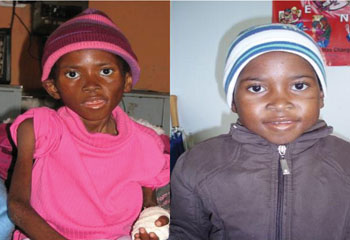28.1.3 Differences in the management of children and adults with HIV
The management of HIV in children, especially the young ones, differs from that of adults. Below are some of these differences:
- Normal CD4 counts are higher in young children than in adults, and decrease with age to reach adult levels around the age of six years. In children younger than six years, it is better to use the percentage of CD4 cells in the blood as a criterion to start ART. This is more stable than the CD4 cell count used in adults.
- Once started on ART, children need to be followed-up more frequently than adults. Their response to ART should be checked by regular monitoring of growth and development (Figure 28.1 illustrates the profound improvement that can be seen in HIV-positive children given ART).
- ARV drug dosages need to be adjusted regularly to account for changing body weight and growth as children develop.
- Communication with children can be challenging. This regards issues related to disclosure, counselling and explaining the need for long-term treatment, particularly adherence to the treatment regimen.

Figure 28.1 A South African child living with HIV. The image on the left was taken immediately prior to ART and the photo on the right shows the marked improvement achieved after only six months of therapy. (http://www.tac.org.za/community/taxonomy/term/49)
Back to previous pagePrevious
28.1.2 Early diagnosis of HIV
